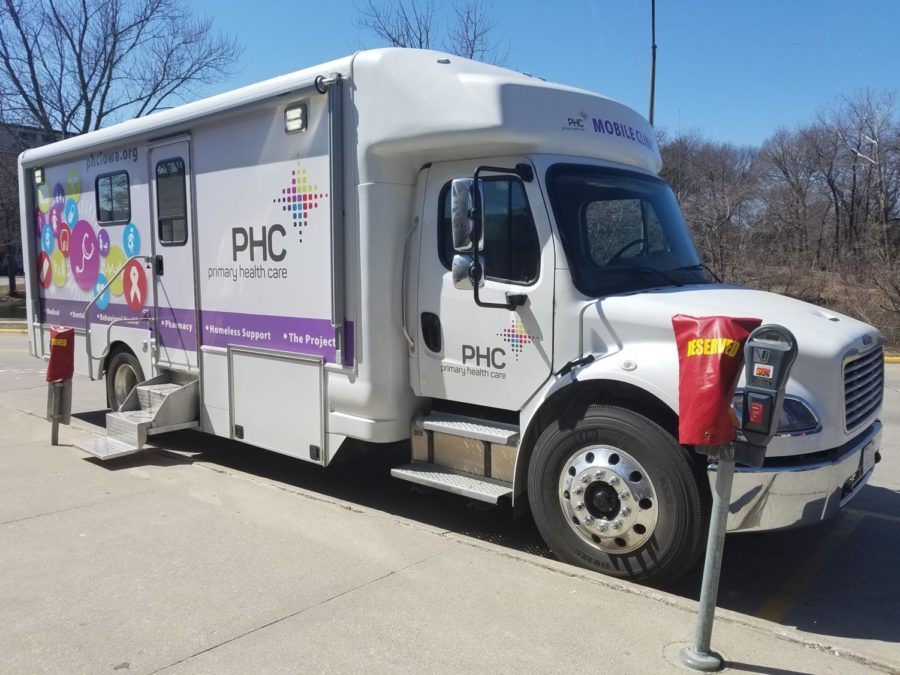Sexually transmitted infections at an all-time high among college students
Multiple times per year, the Primary Healthcare Clinic (PHC) in Ames provides free STD testing, including an HIV test. During the semester, PHC brings its mobile testing unit to campus to give students more access to testing.
May 2, 2021
Sexually transmitted infections and diseases (STIs and STDs) have reached an all-time high in the United States, according to the Centers for Disease Control and Prevention (CDC).
In the CDC’s most recent report detailing data from 2019, there were 2.5 million reported cases of chlamydia, gonorrhea and syphilis. This marked the sixth consecutive year of record-breaking numbers of infections.
There was an increase of approximately 30 percent of reportable STDs between 2015 and 2019.
Raul Romaguera, acting director for the CDC’s Division of STD Prevention, said the increase in STD reported numbers is troubling.
“Our STD defenses are down,” he said. “We must prioritize and focus our efforts to regain lost ground and control the spread of STDs.”
Twenty years ago, gonorrhea rates in the U.S. were extremely low, and syphilis was almost completely eliminated. Now, there is a sharp spike in syphilis transmission, especially in newborns, called congenital syphilis. The rate of congenital syphilis nearly quadrupled from 2015 to 2019.
The CDC does not have a complete data set for the 2020 STD rates, but preliminary data suggests the rate of STDs has not declined.
“Preliminary 2020 data suggest that many of these concerning trends continued in 2020, when much of the country experienced major disruptions to STD testing and treatment services due to the COVID-19 pandemic,” according to the CDC in its report.
While STDs are a problem across the United States, certain minority groups were hit hardest.
In 2019, the STD rates among Black people were five to eight times that of non-Hispanic white people. Native American, Alaska Native, Native Hawaiian and other Pacific Islander people were three to five times more likely to report an STD, and Hispanic or Latinx people were one to two times more likely than white people to report, according to the CDC.
Racial and ethnic minorities were not the only groups that experienced a spike. Gay and bisexual men made up almost 50 percent of all primary and secondary syphilis cases. A gay or bisexual man was also 42 times more likely to report gonorrhea than a heterosexual man in some areas of the country.
One of the most concerning factors of STD transmission had to do with age. People aged 15 to 24 make up 61 percent of chlamydia cases and 42 percent of gonorrhea cases.
Jo Valentine, associate director of the Office of Health Equity in CDC’s Division of STD Prevention, said in order to reduce the rate of STD spread, certain communities need specific help to reduce disparities.
“To effectively reduce disparities, the social, cultural and economic conditions that make it more difficult for some populations to stay [sexually] healthy must be addressed,” she said in a previous interview. “These include poverty, unstable housing, drug use, lack of medical insurance or regular medical providers and high burden of STDs in some communities.”
According to “Condom Use in Heavy Drinking College Students: The Importance of Always Using Condoms,” 80 to 90 percent of college students are sexually active. However, only 26.4 percent of sexually active college students report always using condoms.
While preventing pregnancy is possible with many forms of birth control, preventing STDs is best accomplished by consistent latex condom use.
Dr. Andrea Silvers, a family doctor at Unity Point Clinic, said it is incredibly important for adults to protect themselves.
“Sexually transmitted infections occur at all ages of adults who are sexually active, and infections can cause pain, infertility, cancer and even death,” Silvers said. “It is critical for everyone to protect themselves during any sexual intimacy with condoms until they are in a long-term, monogamous relationship and ready to share DNA.”
Gabrielle Erbes, a freshman in general preveterinary medicine, encouraged students to get tested and use protection.
“Most people don’t even know they have one until it’s too late,” Erbes said. “It is important to protect ourselves.”

















